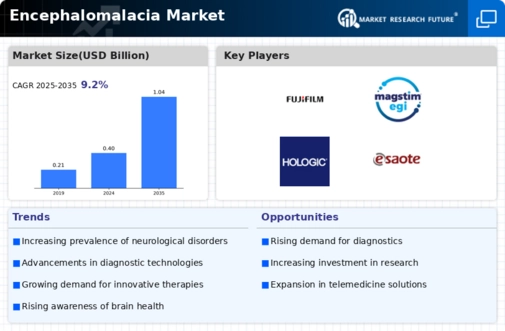Market Trends
Key Emerging Trends in the Encephalomalacia Market
A neurological illness that softens or eliminates brain tissue drives the encephalomalacia market. Better diagnostic techniques, a better understanding of causes, and an emphasis on neurorehabilitation treatments are changing the encephalomalacia industry. Imaging technologies like MRI and CT enable encephalomalacia industry developments. These imaging methods can detect encephalomalacia-related disorders earlier and more precisely by revealing brain regions. The market prioritizes precise diagnosis and early encephalomalacia detection. Imaging techniques and disease information enable earlier therapy and better patient outcomes. Neurogenetic science is altering the market. Precision medicine can personalize encephalomalacia therapy to each person's genetics by identifying the hereditary causes. Treatments become increasingly specialized and effective. Neurorehabilitation for encephalomalacia is growing. Neuroplastic rehabilitation strives to enhance encephalomalacia patients' functional outcomes and quality of life through tailored therapies and interventions. The market indicates more children and newborns getting encephalomalacia tests and treatments. Early diagnosis and treatment of neonatal hypoxic-ischemic encephalopathy improves neurological outcomes. Artificial intelligence (AI) in diagnostics is popular. AI technologies analyze complex neuroimaging data to help doctors diagnose encephalomalacia faster and more accurately. Recent business changes include brain monitoring technology advances. Continuously monitoring brain activity and oxygen levels can detect encephalomalacia early, especially in critical care, allowing treatment to begin. Market dynamics depend on people following regulators' rules and standardizing problem diagnosis. Following the rules ensures safe and effective encephalomalacia diagnosis and therapy. The rise of patient-centered care is changing the market. Encephalomalacia patients and family benefit from support groups and patient welfare organizations. Counseling and emotional support are provided. Academic institutions, healthcare groups, and medication corporations collaborate increasingly. These agreements attempt to share resources, knowledge, and speed up encephalomalacia research, which could lead to novel treatments. Telemedicine is growing in encephalomalacia. Doctors can give patients specialized care and guidance via remote chats, making them simpler to reach, especially in remote or impoverished areas.


















Leave a Comment